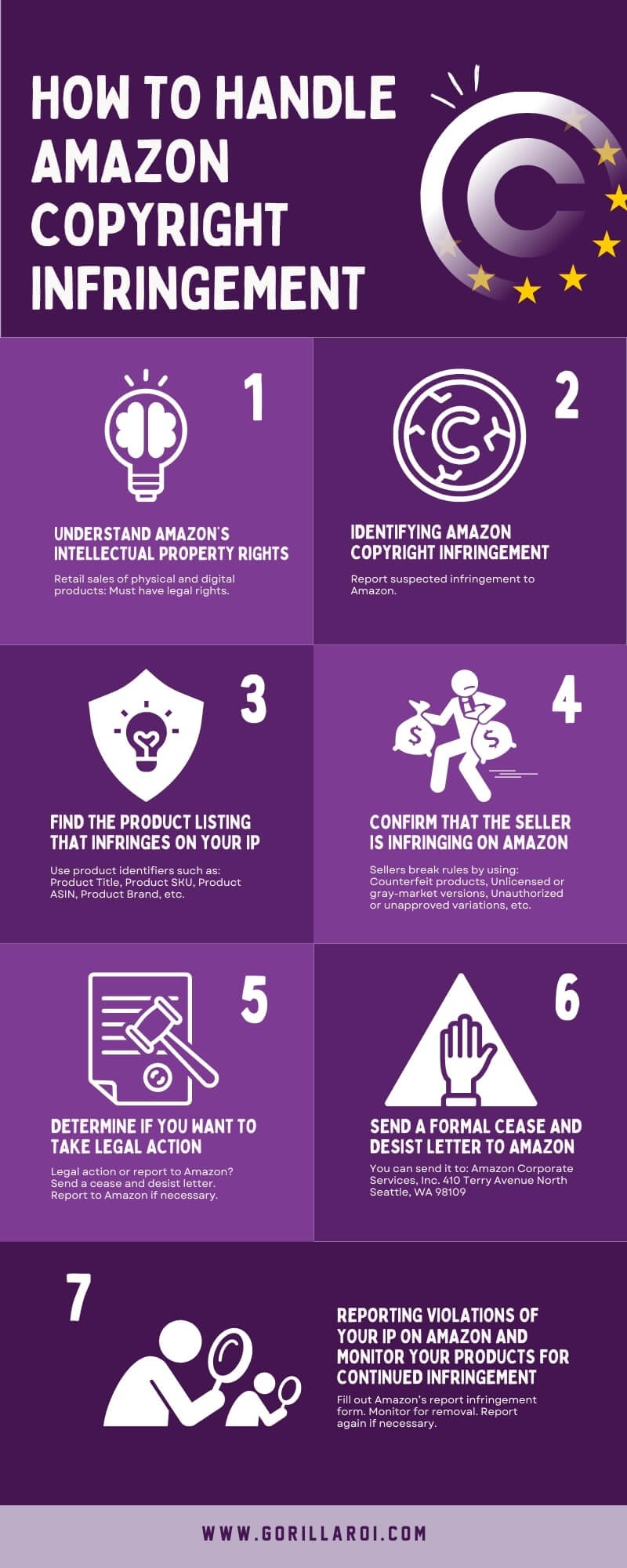
Article Summary (TL;DR)
✅ Explore strategies for avoiding Amazon copyright infringement issues, such as conducting thorough research on product sourcing, obtaining proper licensing, and respecting intellectual property rights.
✅ Understand the implications of copyright infringement on Amazon, including potential consequences and penalties for sellers.
✅ Learn about steps to take if faced with an Amazon copyright infringement claim on Amazon, including responding promptly, providing evidence of ownership or authorization, and seeking legal advice if necessary.
Amazon is the world’s largest online retailer, with over 500 million visitors annually. It’s also full of counterfeit products.
Brands selling their authentic product on Amazon will inevitably run into Amazon copyright infringement from time to time, resulting in an Amazon infringement report.
While Amazon trademark infringement isn’t something you can prevent altogether, there are steps you can do to reduce instances of copyright infringement on Amazon and protect your brand moving forward.
Regardless of how difficult it is to report infringers on Amazon as an individual or business owner, you must know how to counter this ahead of time so that you can do so confidently if the situation ever arises.
This article will have steps to show you how to report IP copyright infringement on Amazon (or Amazon IP infringement) and what to do if someone is selling your authentic designs without permission.
Amazon Report Infringement Steps
What is Amazon Copyright Infringement?
When someone sells an item using your brand name, designs, or product images without permission, it’s called copyright infringement.
According to the Amazon Trademark Infringement Policy, Amazon copyright infringement is a major issue for third-party sellers, especially in the fashion and beauty category, where many sell counterfeit products.
Certain things, like photos of your product, are protected by copyright laws. This means you are the copyright owner of those images and can decide how or who can use them.
When someone uses your images without permission, it could affect your sales.
Customers might purchase the fake product because they think it’s authentic, then leave bad reviews when they don’t get the quality they were expecting.
Copyright infringement can also lead to brand confusion or damage your reputation as sellers and intellectual property rights owners.
If customers see your product sold in a way that’s inconsistent with what they’re used to, they could lose faith in the product and your brand.
How to Report Copyright Infringement on Amazon

Step 1: Understand Amazon’s Intellectual Property Rights
Familiarize yourself with the Amazon copyright infringement rules. Amazon has a set of intellectual property (IP) rights that govern what users can and cannot do on the platform.
They are as follows:
- Retail sales of physical products: Amazon sellers can’t sell products that will fall under intellectual property rights infringement. If someone sells a physical product on Amazon, they must have the legal right to do so. They must own the product or have permission from the owner of the IP rights to sell a counterfeit version of that product. If a seller infringes on your IP, you can report them to Amazon.
- Retail sales of digital products: Amazon sellers can’t sell digital products that fall under intellectual property infringement. If someone sells a digital product on Amazon, they must have the legal right to do so, and they must own the product or have permission from the owner of the IP rights to sell a version of that product. If a seller infringes on your IP, you can report them to Amazon.
Step 2: Identifying Amazon Copyright Infringement
How to report copyright infringement on Amazon?
If you’re certain that a seller on Amazon is selling a product that infringes on your IP rights, you can report them to Amazon for investigation.
However, Amazon will not just remove the product from the site because of your report. They have strict rules about what constitutes IP or copyright infringement and will not remove products from the site for no good reason.
If you’re unsure whether a product infringes on your IP, there are four steps to determine whether or not it is copyright infringement. You can then use this information to report the seller to Amazon:
Check your website: If you have a website that sells any of your products, you can check it to see if any of the products on Amazon that appear to infringe on your IP are also listed on your site.
If they are, you can contact the seller and ask them to stop selling your product with a cease and desist letter.
If the seller continues to sell your product after you’ve sent a C&D letter, then you can use the version listed on your site as evidence to report the seller for IP infringement on Amazon (Amazon report infringement).
Search the internet for products that appear to be infringing: If you don’t have a website but still have products on Amazon that infringe on your IP, you can use Google or other search engines to find those products online.
Compare the prices of products on Amazon that appear to be infringing with their prices on legitimate websites: If you don’t have a website and you can’t find any products that appear to be infringing on legitimate websites, you can compare the prices of the same products being sold on Amazon.
If the suspicious Amazon products are significantly cheaper, there is a good chance that they are counterfeit products.
Compare the product details of products on Amazon that appear to be infringing with those of the legitimate version: If you don’t have a website and the Amazon products are selling for a significantly lower price than the same products on legitimate websites, they’re probably counterfeit products.
Step 3: Find the Product Listing that Infringes on Your IP
Find the product listing that infringes on your IP. Once you’ve identified the way that the seller is violating your IP, you’ll want to find the product listing that is breaking the rules.
You can do this by using the following product identifiers:
- “Product Title”
- “Product SKU”
- “Product ASIN”
- “Product Brand”
- “Product Manufacturer”
- “My Product Description”
Step 4: Confirm that the Seller is Infringing on Amazon
Not every product listing on Amazon that appears to infringe on your IP rights is actually a trademark infringement. A seller can break Amazon’s rules without trademark infringement in several ways.
You must review Amazon’s marketplace rules to confirm that the seller infringes on your IP.
Amazon’s marketplace rules are complex, and there are many different ways that a seller can break the rules without trademark infringement.
There are three ways a seller can break Amazon’s rules without infringing on your IP:
- The product could be counterfeit: Counterfeit products are illegal copies of legitimate products and are often manufactured and sold by unscrupulous companies. To ensure that the product isn’t counterfeit, you can check the product label against the product label of the real thing. The product may be counterfeit if there are significant differences between the two labels.
- The product could be an unlicensed or grey-market version: A grey-market product is a version authorized for sale in one country but sold in another without proper authorization. To ensure that the product is not unlicensed or a grey-market version, you can confirm that the seller is authorized to sell the product. You can do this by reading the seller’s product information and viewing their Seller Central profile. If the seller’s profile doesn’t state that they have permission to sell the product, they are most likely selling an unlicensed or grey-market version.
- The product could be an unauthorized or unapproved variation: An unauthorized variation is a variation of the product not approved by the company that owns the IP rights to the product. An unapproved variation is an approved product but unlisted on the company website. To ensure that the product is not an unauthorized or unapproved variation, you can confirm that the seller is properly using variations. You can also confirm that the seller is authorized to sell the product.
Step 5: Determine If You Want to Take Legal Action or Report the Copyright Infringement
If you discover that someone is selling your products on Amazon without your permission, you should first determine whether you want to take legal action or report the infringement.
If the person sells only a few products, you can take legal action against them and send them a cease and desist letter.
However, taking legal action is expensive and time-consuming. You also must be 100% sure they are violating your rights.
If, however, the infringer sells many products or sells them at a high volume, you must report the copyright infringement to Amazon.
Amazon’s rules state that they will not remove products from their marketplace unless the owner of the IP (in this case, you) files an Amazon copyright infringement claim.
If you send the infringer a cease and desist letter, they will most likely ignore it. However, if you report the infringement to Amazon and they agree that the products violate your rights, they will remove the products from their site.
Step 6: Send a Formal Cease and Desist Letter to Amazon

If you’ve determined to send Amazon copyright infringement claims, you must do so in writing.
If you’re in the U.S., send your letter to Amazon’s general counsel at the following address: Amazon Corporate Services, Inc. 410 Terry Avenue North Seattle, WA 98109.
Amazon’s general counsel will decide whether to take action against the infringer.
If Amazon agrees that the products are violating your rights and you have sent them a letter, they will remove them from their site.
If Amazon refuses to remove the infringer’s products, you can choose to file a formal Amazon report of infringement with their IP department.
Step 7: Reporting Violations of Your IP on Amazon
To report a violation of your intellectual property on Amazon, you must visit their IP complaint page and fill out Amazon’s report infringement form.
Amazon’s IP complaint page should guide you through the process of reporting an Amazon copyright infringement violation.
However, if you get stuck, these are the most important parts of the form:
- Product Identity: This is the product that the infringer is selling.
- IP: This is the type of IP that you are filing a complaint against the infringer for.
- Detail: In this section, you must thoroughly explain how the infringer violates your IP. You should include specific examples such as their sales page, product descriptions, and reviews.
- Remedies: This is where you tell Amazon how you want them to handle the complaint. You can select “Please increase efforts to remove this product” or “Please remove this product.”
- Additional Information: In this section, you can include any information that might help Amazon with its investigation. You can also upload evidence, such as screenshots of the infringement or your IP registration information.
Step 8: Monitor Your Products for Continued Infringement
If you have reported an IP infringement, Amazon can take a few weeks to months after submitting the Amazon infringement form before they resolve the complaint.
While you wait, you can monitor your products to see if the infringer has removed them. If they have not, you can report them again.
If the complaint is something Amazon has to review (such as a registered copyright violation) manually, it might take much longer for them to resolve. In that case, you will want to monitor all the products that you own.
If you find someone selling your products on Amazon without your permission, you can report the infringement. However, it’s important to note that the process is long and complicated.
You must be aware of the specific rules that the infringer is breaking and how to report them to Amazon. To protect your IP and rights, you must report infringements to Amazon.
Should I File An Amazon Infringement Claim With An Intellectual Property Attorney?
When discovering an infringing product listing, intellectual property owners can use the affordable resources provided by the Amazon brand registry and the infringement notification form.
The procedure is actually quite straightforward for an individual to file an IP claim.
But it’s crucial to get help from an intellectual property attorney when a thorough clearance is required to make sure the complaint is legitimate under US IP Laws.
Intellectual Property Protection
Be proactive and protect your brand against trademark infringement issues. Amazon has a strict policy regarding Amazon copyright infringement, but it’s up to you to report it.
Ensure you follow the steps above to protect your brand and keep your authentic product from being removed from Amazon.
Final word of caution is to not abuse the system as you could get a counter copyright infringement claim and backfire to you.
Comments
One response to “8 Steps to Report Amazon Copyright Infringement”
-
If you are going to be using Amazon for your online store, you would also want to conduct your own search of the Amazon store for confusingly similar names. That will help you avoid an Amazon takedown of your product. Once you find a name without conflicts, you will want to apply to register that trademark. Know more https://www.iregistertrademarks.com/amazon-takedown-infringement/
Related Posts

10 Profitable Product Categories for Amazon Affiliates 2025
What you’ll learn Amazon is a favorite for experienced and…

Unlock the Secret to a Profitable Automated Amazon Store: How to Build a Hands-Free Income Stream
Ever dreamed of running a profitable Amazon business while sipping…

Master Amazon New Restricted Keywords: A Seller’s Guide to Success
Changes to Amazon’s restricted keywords list have taken a lot…







Leave a Reply